Preparation and Comprehensive Properties of a High-Radiation-Shielding UHPC by Using Magnetite Fine Aggregate
Abstract
1. Introduction
2. Materials and Methods
2.1. Raw Materials
2.2. Mixture Design of MUHPC
2.3. Specimen Fabrication
2.4. Experimental Methods
2.4.1. Fluidity Test
2.4.2. Static Compressive Strength Test
2.4.3. Dynamic Compressive Strength Test
2.4.4. High-Temperature Treatment
2.4.5. Gamma Ray Shielding Experiment
2.4.6. Hydration Products, Micromorphology, and Pore Structures
3. Results
3.1. Working Performance
3.2. Static Compressive Strength
3.3. Dynamic Compressive Strength
3.4. Compressive Strength at Elevated Temperatures
3.5. Radiation Shielding Performance at Room Temperature
3.6. Radiation Shielding Performance at Elevated Temperatures
3.7. Hydration Products
3.8. Micromorphology
3.9. Micropore Structures
4. Conclusions
Author Contributions
Funding
Institutional Review Board Statement
Informed Consent Statement
Data Availability Statement
Acknowledgments
Conflicts of Interest
References
- Akkurt, I.; Akyildirim, H.; Mavi, B.; Kilincarslan, S.; Basyigit, C. Gamma-ray shielding properties of concrete including barite at different energies. Prog. Nucl. Energy 2010, 52, 620–623. [Google Scholar] [CrossRef]
- Azeez, M.O.; Ahmad, S.; Al-Dulaijan, S.U.; Maslehuddin, M.; Naqvi, A.A. Radiation shielding performance of heavy-weight concrete mixtures. Constr. Build. Mater. 2019, 224, 284–291. [Google Scholar] [CrossRef]
- Singh, C.; Singh, T.; Kumar, A.; Mudahar, G.S. Energy and chemical composition dependence of mass attenuation coefficients of building materials. Ann. Nucl. Energy 2004, 31, 1199–1205. [Google Scholar] [CrossRef]
- Yan, J.; Lin, Y.; Wang, Z.; Fang, T.; Ma, J. Failure mechanism of a prestressed concrete containment vessel in nuclear power plant subjected to accident internal pressure. Ann. Nucl. Energy 2019, 133, 610–622. [Google Scholar] [CrossRef]
- Lawrence, D.J.; Feldman, W.C.; Gold, R.E.; Goldsten, J.O.; McNutt, R.L. The neutron, gamma-ray, X-ray spectrometer (NGXS): A compact instrument for making combined measurements of neutrons, gamma-rays, and X-rays. Acta Astronaut. 2014, 93, 524–529. [Google Scholar] [CrossRef]
- Zayed, A.M.; Masoud, M.A.; Rashad, A.M.; El-Khayatt, A.M.; Sakr, K.; Kansouh, W.A.; Shahien, M.G. Influence of heavyweight aggregates on the physico-mechanical and radiation attenuation properties of serpentine-based concrete. Constr. Build. Mater. 2020, 260, 120473. [Google Scholar] [CrossRef]
- Zervides, C.; Sassis, L.; Kefala-Karli, P.; Christou, V.; Derlagen, A.; Papapetrou, P.; Heraclides, A. Assessing radiation protection knowledge in diagnostic radiography in the Republic of Cyprus. A questionnaire survey. Radiography 2020, 26, e88–e93. [Google Scholar] [CrossRef]
- Li, C.; Zhang, C.; Chen, Y.; Zuo, J.; Chen, J. The study on safety goals and public acceptance of nuclear power. Energy Procedia 2013, 39, 415–422. [Google Scholar]
- Jin, T.; Kim, J. What is better for mitigating carbon emissions–Renewable energy or nuclear energy? A panel data analysis. Renew. Sustain. Energy Rev. 2018, 91, 464–471. [Google Scholar] [CrossRef]
- Mahmood, N.; Danish; Wang, Z.; Zhang, B. The role of nuclear energy in the correction of environmental pollution: Evidence from Pakistan. Nucl. Eng. Technol. 2020, 52, 1327–1333. [Google Scholar] [CrossRef]
- Mergener, M.; Rhoden, C.R.; Amantéa, S.L. Nuclear abnormalities in cells from nasal epithelium: A promising assay to evaluate DNA damage related to air pollution in infants. J. Pediatr. 2014, 90, 632–636. [Google Scholar] [CrossRef] [PubMed][Green Version]
- Portugal-Pereira, J.; Ferreira, P.; Cunha, J.; Szklo, A.; Schaeffer, R.; Araújo, M. Better late than never, but never late is better: Risk assessment of nuclear power construction projects. Energy Policy 2018, 120, 158–166. [Google Scholar] [CrossRef]
- Suwanmaneechot, P.; Bongkarn, T.; Joyklad, P.; Julphunthong, P. Experimental and numerical evaluation of gamma-ray attenuation characteristics of concrete containing high-density materials. Constr. Build. Mater. 2021, 294, 123614. [Google Scholar] [CrossRef]
- Sharifi, S.; Bagheri, R.; Shirmardi, S.P. Comparison of shielding properties for ordinary, barite, serpentine and steel–magnetite concretes using MCNP-4C code and available experimental results. Ann. Nucl. Energy 2013, 53, 529–534. [Google Scholar] [CrossRef]
- Akkurt, I.; Basyigit, C.; Kilincarslan, S.; Mavi, B. The shielding of γ-rays by concretes produced with barite. Prog. Nucl. Energy 2005, 46, 1–11. [Google Scholar] [CrossRef]
- Al-Tersawy, S.H.; El-Sadany, R.A.; Sallam, H.E.M. Experimental gamma-ray attenuation and theoretical optimization of barite concrete mixtures with nanomaterials against neutrons and gamma rays. Constr. Build. Mater. 2021, 289, 123190. [Google Scholar] [CrossRef]
- Aygün, B.; Şakar, E.; Agar, O.; Sayyed, M.I.; Karabulut, A.; Singh, V.P. Development of new heavy concretes containing chrome-ore for nuclear radiation shielding applications. Prog. Nucl. Energy 2021, 133, 103645. [Google Scholar] [CrossRef]
- Horszczaruk, E.; Sikora, P.; Zaporowski, P. Mechanical properties of shielding concrete with magnetite aggregate subjected to high temperature. Procedia Eng. 2015, 108, 39–46. [Google Scholar] [CrossRef]
- Kim, I.S.; Choi, S.Y.; Yang, E.I. Evaluation of durability of concrete substituted heavyweight waste glass as fine aggregate. Constr. Build. Mater. 2018, 184, 269–277. [Google Scholar] [CrossRef]
- Martínez-Barrera, G.; Ureña-Nuñez, F.; Gencel, O.; Brostow, W. Mechanical properties of polypropylene-fiber reinforced concrete after gamma irradiation. Compos. Part A Appl. Sci. Manuf. 2011, 42, 567–572. [Google Scholar] [CrossRef]
- Tufekci, M.M.; Gokce, A. Development of heavyweight high performance fiber reinforced cementitious composites (HPFRCC)–Part I: Mechanical properties. Constr. Build. Mater. 2017, 148, 559–570. [Google Scholar] [CrossRef]
- AbuAlRoos, N.J.; Amin, N.A.B.; Zainon, R. Conventional and new lead-free radiation shielding materials for radiation protection in nuclear medicine: A review. Radiat. Phys. Chem. 2019, 165, 108439. [Google Scholar] [CrossRef]
- Perry, M.; Yan, Z.; Sun, Z.; Zhang, L.; Niewczas, P.; Johnston, M. High stress monitoring of prestressing tendons in nuclear concrete vessels using fibre-optic sensors. Nucl. Eng. Des. 2014, 268, 35–40. [Google Scholar] [CrossRef]
- Yılmaz, E.; Baltas, H.E.; Kırıs, İ.; Ustabas, U.; Cevik, A.M. El-Khayatt, Gamma ray and neutron shielding properties of some concrete materials. Ann. Nucl. Energy 2011, 38, 2204–2212. [Google Scholar] [CrossRef]
- Liu, J.; Tian, Q.; Wang, Y.; Li, H.; Xu, W. Evaluation Method and Mitigation Strategies for Shrinkage Cracking of Modern Concrete. Engineering 2021, 7, 348–357. [Google Scholar] [CrossRef]
- Zhao, H.; Jiang, K.; Yang, R.; Tang, Y.; Liu, J. Experimental and theoretical analysis on coupled effect of hydration, temperature and humidity in early-age cement-based materials. Int. J. Heat Mass Transf. 2020, 146, 118784. [Google Scholar] [CrossRef]
- Ouda, A.S.; Abdel-Gawwad, H.A. The effect of replacing sand by iron slag on physical, mechanical and radiological properties of cement mortar. HBRC J. 2017, 13, 255–261. [Google Scholar] [CrossRef]
- Çullu, M.; Bakırhan, E. Investigation of radiation absorption coefficients of lead-zinc mine waste rock mixed heavy concrete at 662–1460 keV energy range. Constr. Build. Mater. 2018, 173, 17–27. [Google Scholar] [CrossRef]
- Saidani, K.; Ajam, L.; Ouezdou, M.B. Barite powder as sand substitution in concrete: Effect on some mechanical properties. Constr. Build. Mater. 2015, 95, 287–295. [Google Scholar] [CrossRef]
- González-Ortega, M.A.; Cavalaro, S.H.P.; Aguado, A. Influence of barite aggregate friability on mixing process and mechanical properties of concrete. Constr. Build. Mater. 2015, 74, 169–175. [Google Scholar] [CrossRef]
- Yang, J.; Wu, H.; Guo, L.; Li, Y.; Li, X.; Wang, S.; Hao, T.; Ji, W. Validation of NECP-Bamboo with BEAVRS and AP1000 measurements. Nucl. Eng. Des. 2021, 376, 111110. [Google Scholar] [CrossRef]
- Hou, D.; Wu, D.; Wang, X.; Gao, S.; Yu, R.; Li, M.; Wang, P.; Wang, Y. Sustainable use of red mud in ultra-high performance concrete (UHPC): Design and performance evaluation. Cem. Concr. Compos. 2021, 115, 103862. [Google Scholar] [CrossRef]
- Yu, R.; Spiesz, P.; Brouwers, H.J.H. Development of an eco-friendly Ultra-High Performance Concrete (UHPC) with efficient cement and mineral admixtures uses. Cem. Concr. Compos. 2015, 55, 383–394. [Google Scholar] [CrossRef]
- Zhang, P.; Wan, J.; Wang, K.; Li, Q. Influence of nano-SiO2 on properties of fresh and hardened high performance concrete: A state-of-the-art review. Constr. Build. Mater. 2017, 148, 648–658. [Google Scholar] [CrossRef]
- Chen, H.; Yu, Y.; Tang, C. Mechanical properties of ultra-high performance concrete before and after exposure to high temperatures. Materials 2020, 3, 770. [Google Scholar] [CrossRef]
- Li, Y.; Zeng, X.; Zhou, J.; Shi, Y.; Umar, H.A.; Long, G.; Xie, Y. Development of an eco-friendly ultra-high performance concrete based on waste basalt powder for Sichuan-Tibet Railway. J. Clean. Prod. 2021, 312, 127775. [Google Scholar] [CrossRef]
- Zhang, Z.; Xu, X. Static and fatigue behavior of rubber-sleeved stud shear connectors as part of field-cast ultra-high performance concrete connections. Materials 2020, 10, 2269. [Google Scholar] [CrossRef]
- Zhang, D.; Tan, K. Effect of various polymer fibers on spalling mitigation of ultra-high performance concrete at high temperature. Cem. Concr. Compos. 2020, 114, 103815. [Google Scholar] [CrossRef]
- Arora, A.; Yao, Y.; Mobasher, B.; Neithalath, N. Fundamental insights into the compressive and flexural response of binder- and aggregate-optimized ultra-high performance concrete (UHPC). Cem. Concr. Compos. 2019, 98, 1–13. [Google Scholar] [CrossRef]
- Bajaber, M.A.; Hakeem, I.Y. UHPC evolution, development, and utilization in construction: A review. J. Mater. Res. Technol. 2021, 10, 1058–1074. [Google Scholar] [CrossRef]
- Chen, S.; Huang, Y.; Gu, P.; Wang, J.-Y. Experimental study on fatigue performance of UHPC-orthotropic steel composite deck. Thin-Walled Struct. 2019, 142, 1–18. [Google Scholar] [CrossRef]
- Huang, H.; Gao, X.; Teng, L. Fiber alignment and its effect on mechanical properties of UHPC: An overview. Constr. Build. Mater. 2021, 296, 123741. [Google Scholar] [CrossRef]
- Oh, T.; You, I.; Banthia, N.; Yoo, D.-Y. Deposition of nanosilica particles on fiber surface for improving interfacial bond and tensile performances of ultra-high-performance fiber-reinforced concrete. Compos. Part B Eng. 2021, 221, 109030. [Google Scholar] [CrossRef]
- Wang, X.; Yu, R.; Shui, Z.; Song, Q.; Liu, Z.; Bao, M.; Liu, Z.; Wu, S. Optimized treatment of recycled construction and demolition waste in developing sustainable ultra-high performance concrete. J. Clean. Prod. 2019, 221, 805–816. [Google Scholar] [CrossRef]
- Jiao, Y.; Zhang, Y.; Guo, M.; Zhang, L.; Ning, H.; Liu, S. Mechanical and fracture properties of ultra-high performance concrete (UHPC) containing waste glass sand as partial replacement material. J. Clean. Prod. 2020, 277, 123501. [Google Scholar] [CrossRef]
- Wu, Z.; Shi, C.; He, W. Comparative study on flexural properties of ultra-high performance concrete with supplementary cementitious materials under different curing regimes. Constr. Build. Mater. 2017, 136, 307–313. [Google Scholar] [CrossRef]
- Zhang, H.; Ji, T.; Lin, X. Pullout behavior of steel fibers with different shapes from ultra-high performance concrete (UHPC) prepared with granite powder under different curing conditions. Constr. Build. Mater. 2019, 211, 688–702. [Google Scholar] [CrossRef]
- Rashid, R.S.M.; Salem, S.M.; Azreen, N.M.; Voo, Y.L.; Haniza, M.; Shukri, A.A.; Yahya, M.-S. Effect of elevated temperature to radiation shielding of ultra-high performance concrete with silica sand or magnetite. Constr. Build. Mater. 2020, 262, 120567. [Google Scholar] [CrossRef]
- Wang, X.; Yu, R.; Shui, Z.; Zhao, Z.; Song, Q.; Yang, B.; Fan, D. Development of a novel cleaner construction product: Ultra-high performance concrete incorporating lead-zinc tailings. J. Clean. Prod. 2018, 196, 172–182. [Google Scholar] [CrossRef]
- BS-EN-1015-3; Methods of Test for Mortar for Masonry—Part 3: Determination of Consistence of Fresh Mortar (by Flow Table). BSI Publications: London, UK, 2007.
- BS-EN-196-1; Methods of Testing Cement—Part 1: Determination of Strength. BSI Publications: London, UK, 2016.
- Theresa, M.A.; Charles, K.C.; Claus, B.; Benjamin, G.; James, M.; Surendra, P.S.; Eckart, R.B.; Brian, H.G.; John, J.M.; Kay, W.; et al. Ultra-High-Performance Concrete: An Emerging Technology Report; American Concrete Institute: Farmington Hills, MI, USA, 2018; ISBN 978-1-64195-034-3. [Google Scholar]
- Wang, W.; Zhang, X.; Mo, Z.; Chouw, N.; Li, Z.; Xu, Z.-D. A comparative study of impact behaviour between natural flax and glass FRP confined concrete composites. Constr. Build. Mater. 2020, 241, 117997. [Google Scholar] [CrossRef]
- Li, N.; Jin, Z.Q.; Long, G.; Chen, L.; Fu, Q. Impact resistance of steel fiber-reinforced self-compacting concrete (SCC) at high strain rates. J. Build. Eng. 2021, 38, 102212. [Google Scholar] [CrossRef]
- Rashad, A.M.; Zeedan, S.R. A preliminary study of blended pastes of cement and quartz powder under the effect of elevated temperature. Constr. Build. Mater. 2012, 29, 672–681. [Google Scholar] [CrossRef]
- Hossain, K.M.A. High strength blended cement concrete incorporating volcanic ash: Performance at high temperatures. Cem. Concr. Compos. 2006, 28, 535–545. [Google Scholar] [CrossRef]
- Zhang, P.; Gao, Z.; Wang, J.; Guo, J.; Hu, S.; Ling, Y. Properties of fresh and hardened fly ash/slag based geopolymer concrete: A review. J. Clean. Prod. 2020, 270, 122389. [Google Scholar] [CrossRef]
- Georgali, B.; Tsakiridis, P.E. Microstructure of fire-damaged concrete. A case study. Cem. Concr. Compos. 2005, 27, 255–259. [Google Scholar] [CrossRef]
- Khan, M.U.; Ahmad, S.; Naqvi, A.A.; Al-Gahtani, H.J. Shielding performance of heavy-weight ultra-high-performance concrete against nuclear radiation. Prog. Nucl. Energy 2020, 130, 103550. [Google Scholar] [CrossRef]
- Sikora, P.; Elrahman, M.A.; Horszczaruk, E.; Brzozowski, P.; Stephan, D. Incorporation of magnetite powder as a cement additive for improving thermal resistance and gamma-ray shielding properties of cement-based composites. Constr. Build. Mater. 2019, 204, 113–121. [Google Scholar] [CrossRef]
- Oberer, R.B.; Gunn, C.A.; Chiang, L.G. Small-angle Compton scattering used to determine the depth of a radioactive source in material and to estimate gamma-ray attenuation, Nuclear Instruments and Methods in Physics Research Section A: Accelerators, Spectrometers. Detect. Assoc. Equip. 2013, 722, 65–70. [Google Scholar] [CrossRef]
- Wu, C.-R.; Hong, Z.-Q.; Yin, Y.-H.; Kou, S.-C. Mechanical activated waste magnetite tailing as pozzolanic material substitute for cement in the preparation of cement products. Constr. Build. Mater. 2020, 252, 119129. [Google Scholar] [CrossRef]
- Li, G.; Zhou, J.; Yue, J.; Gao, X.; Wang, K. Effects of nano-SiO2 and secondary water curing on the carbonation and chloride resistance of autoclaved concrete. Constr. Build. Mater. 2020, 235, 117465. [Google Scholar] [CrossRef]
- Li, G.; Ding, Y.; Gao, T.; Qin, Y.; Lv, Y.; Wang, K. Chloride resistance of concrete containing nanoparticle-modified polymer cementitious coatings. Constr. Build. Mater. 2021, 299, 123736. [Google Scholar] [CrossRef]
- Baalamurugan, J.; Kumar, V.G.; Chandrasekaran, S.; Balasundar, S.; Venkatraman, B.; Padmapriya, R.; Raja, V.K.B. Recycling of steel slag aggregates for the development of high density concrete: Alternative & environment-friendly radiation shielding composite. Compos. Part B Eng. 2021, 216, 108885. [Google Scholar]
- El-Sayed, T.A. Performance of heavy weight concrete incorporating recycled rice straw ash as radiation shielding material. Prog. Nucl. Energy 2021, 135, 103693. [Google Scholar] [CrossRef]
- Yao, Y.; Zhang, X.; Li, M.; Yang, R.; Jiang, T.; Lv, J. Investigation of gamma ray shielding efficiency and mechanical performances of concrete shields containing bismuth oxide as an environmentally friendly additive. Radiat. Phys. Chem. 2016, 127, 188–193. [Google Scholar] [CrossRef]
- Azreen, N.M.; Rashid, R.S.M.; Haniza, M.; Voo, Y.L.; Amran, Y.H.M. Radiation shielding of ultra-high-performance concrete with silica sand, amang and lead glass. Constr. Build. Mater. 2018, 172, 370–377. [Google Scholar] [CrossRef]
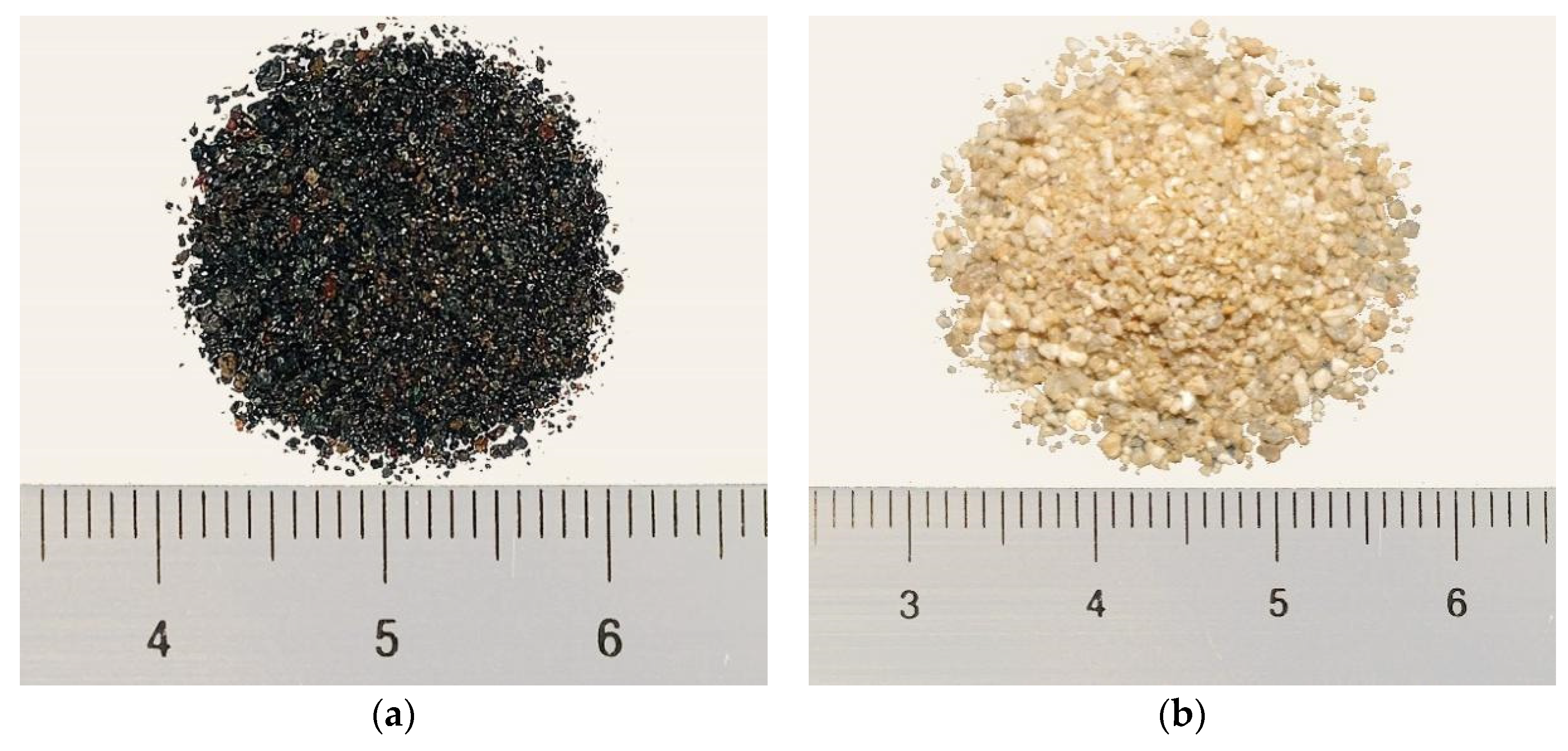

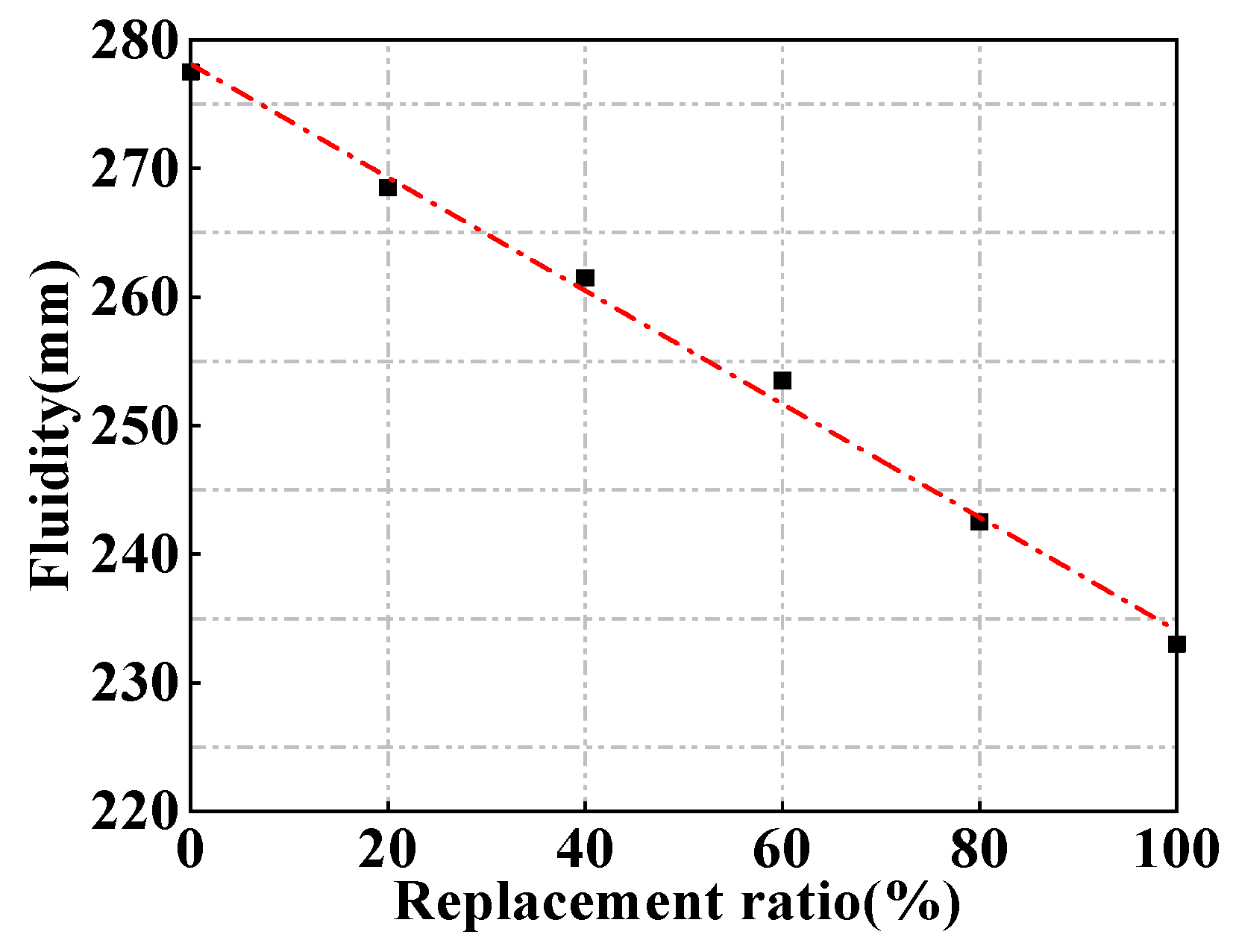
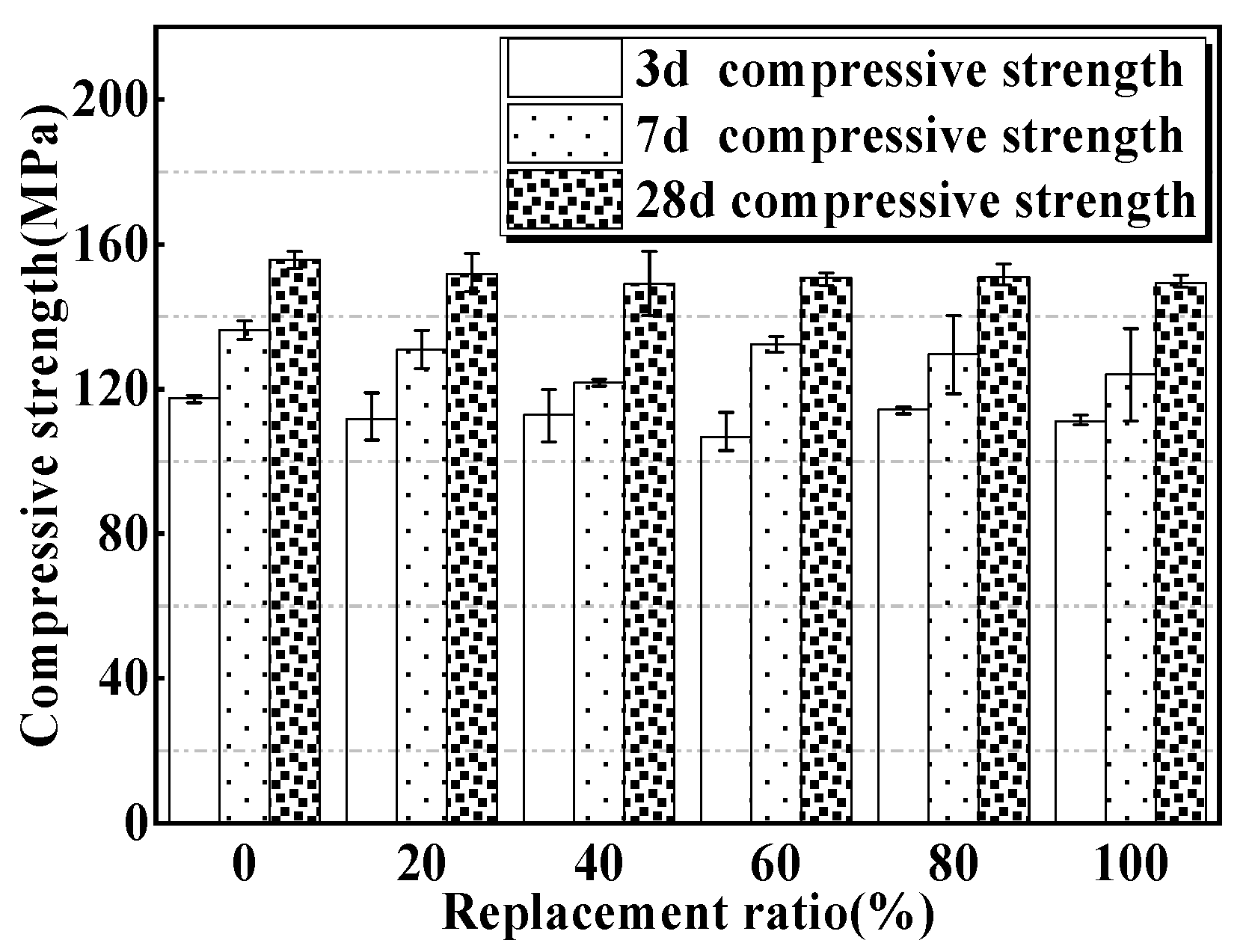

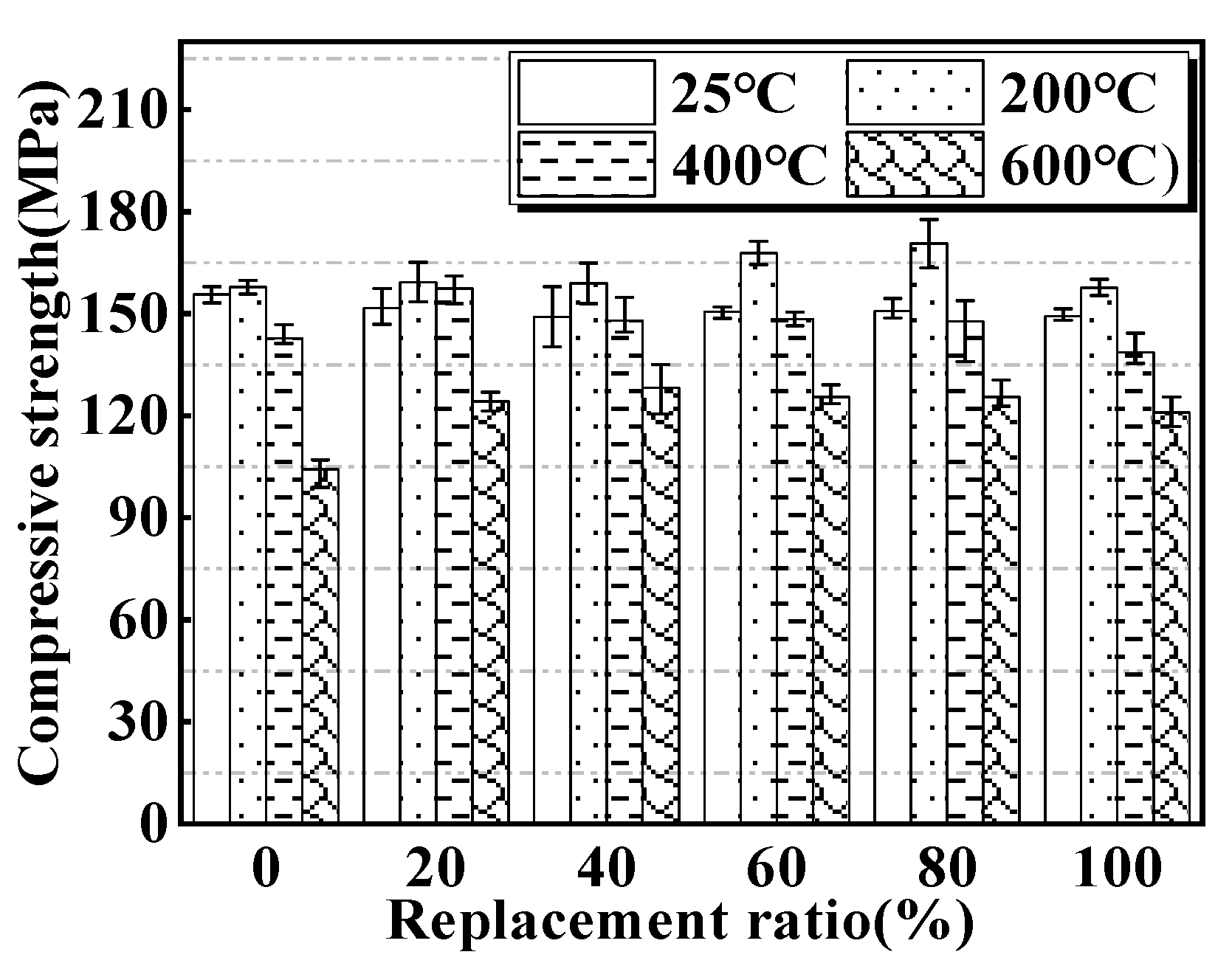
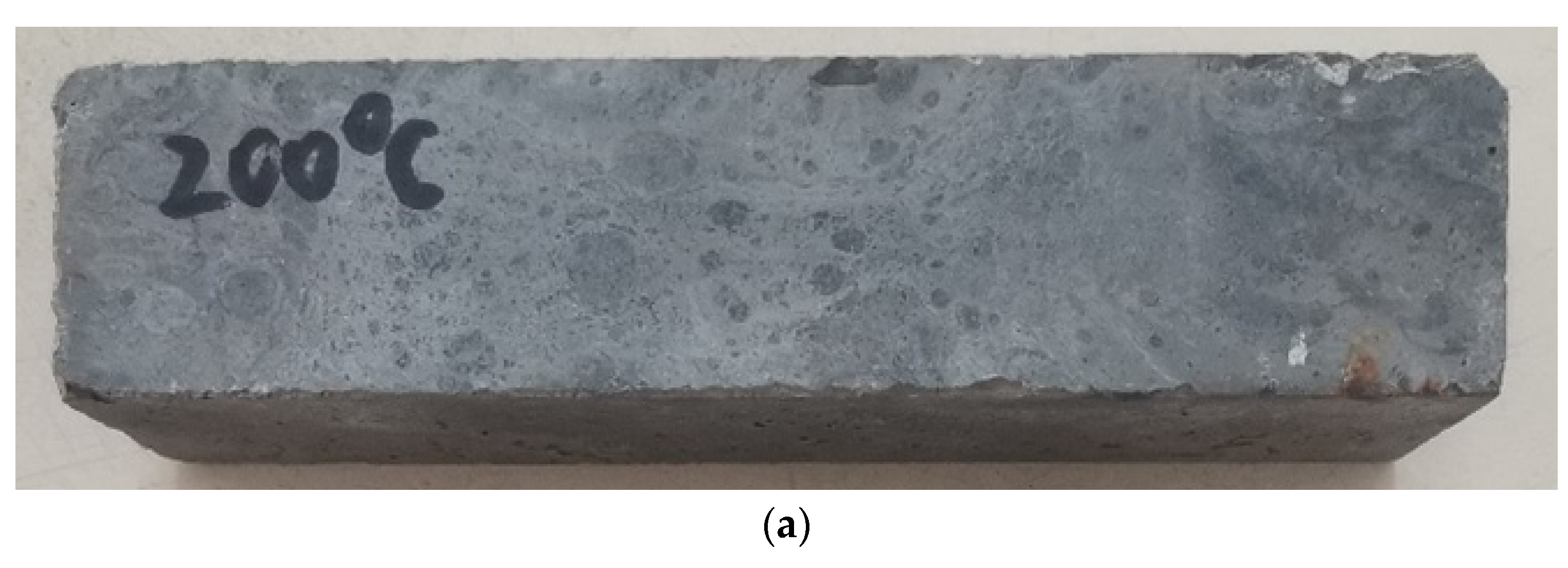

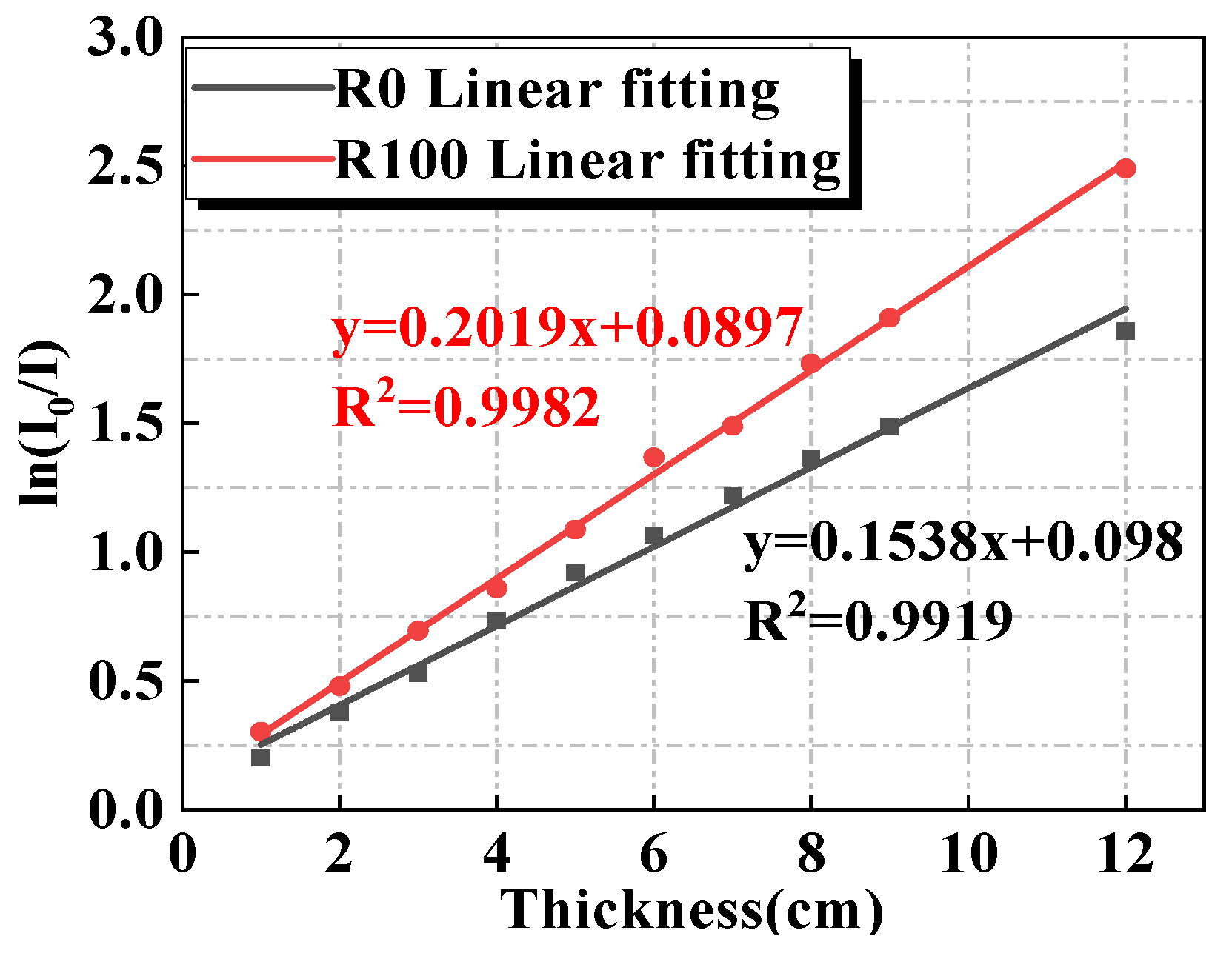

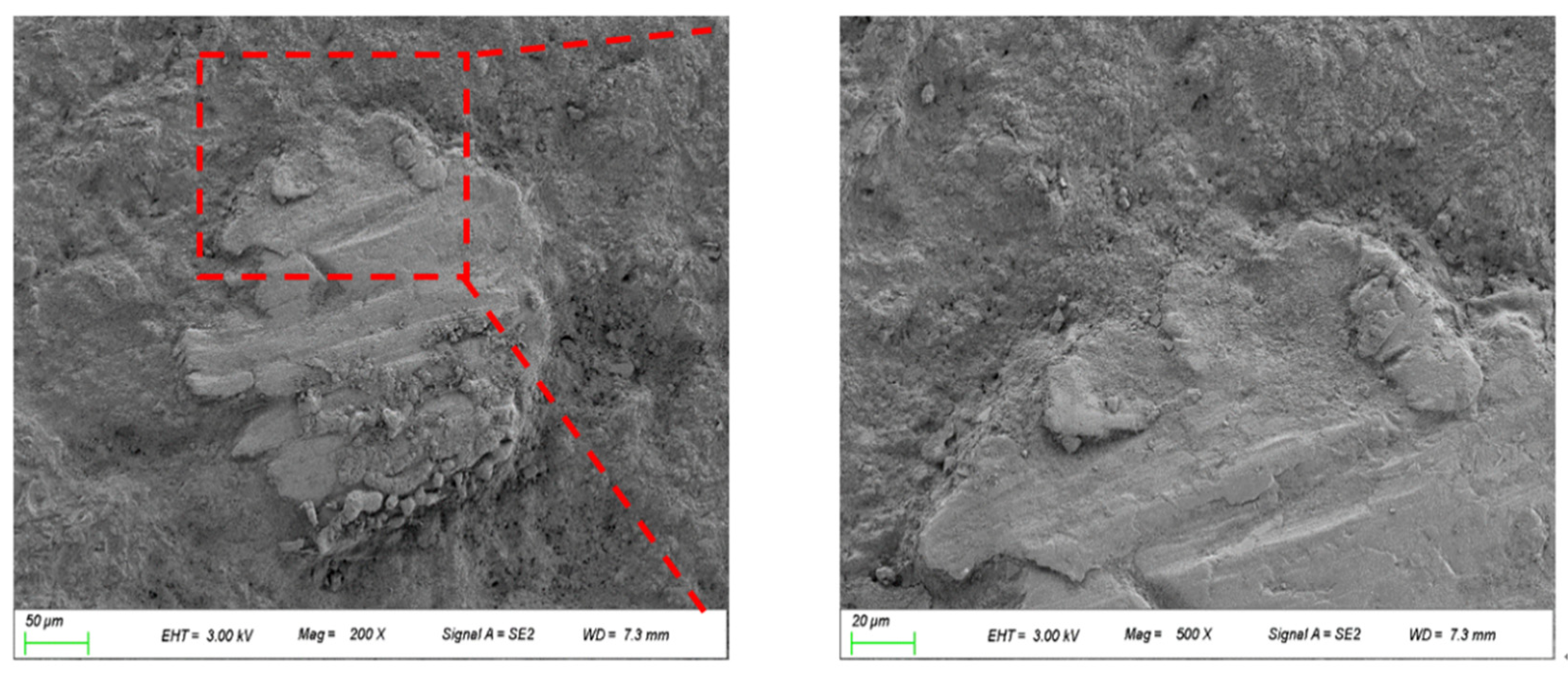


| Item | Na2O | MgO | Al2O3 | SiO2 | P2O5 | SO3 | K2O | CaO | Fe2O3 | LOI |
|---|---|---|---|---|---|---|---|---|---|---|
| Cement | 0.07 | 1.73 | 4.24 | 18.25 | 0.08 | 3.25 | 0.87 | 65.03 | 3.38 | 3.10 |
| Silica Fume | 0.25 | 0.37 | 0.22 | 94.85 | 0.13 | 0.79 | 0.64 | 0.32 | 0.18 | 2.25 |
| Fly Ash | 0.28 | 0.36 | 38.85 | 46.82 | 0.07 | 0.62 | 0.84 | 7.8 | 2.85 | 1.51 |
| Compositions | MgO | Al2O3 | SiO2 | CaO | Fe2O3 | TiO2 | LOI |
|---|---|---|---|---|---|---|---|
| Content (%) | 1.99 | 5.52 | 13.8 | 4.15 | 49.31 | 24 | 1.23 |
| Item | Silica Fume | Cement | Fly Ash | River Sand/mm | Magnetite/mm | Water | Water Reducer | Steel Fiber | ||
|---|---|---|---|---|---|---|---|---|---|---|
| 0–0.6 | 0.6–1.18 | 0–0.6 | 0.6–1.18 | |||||||
| R0 | 101 | 803 | 181 | 717 | 263 | 0 | 0 | 206 | 30 | 156 |
| R20 | 101 | 803 | 181 | 574 | 210 | 287 | 105 | 206 | 30 | 156 |
| R40 | 101 | 803 | 181 | 430 | 158 | 574 | 210 | 206 | 30 | 156 |
| R60 | 101 | 803 | 181 | 287 | 105 | 860 | 316 | 206 | 30 | 156 |
| R80 | 101 | 803 | 181 | 143 | 53 | 1148 | 421 | 206 | 30 | 156 |
| R100 | 101 | 803 | 181 | 0 | 0 | 1434 | 526 | 206 | 30 | 156 |
| Item | Ordinary Concrete [14] | R0 | R20 | R40 | R60 | R80 | R100 |
|---|---|---|---|---|---|---|---|
| ρ (g/cm3) | 2.30 | 2.45 | 2.65 | 2.85 | 3.04 | 3.23 | 3.43 |
| µ (cm−1) | 0.1288 | 0.1538 | 0.1667 | 0.1693 | 0.1891 | 0.1917 | 0.2019 |
| Samples | Porosity (%) | Average Pore Diameter (nm) | Critical Pore Radius (nm) | Median Pore Diameter (nm) |
|---|---|---|---|---|
| R0 | 9.41 | 14.3 | 3.29 | 5.03 |
| R20 | 6.70 | 7.62 | 4.52 | 5.04 |
| R40 | 7.84 | 9.91 | 3.29 | 4.82 |
| R60 | 8.50 | 10.99 | 3.29 | 4.98 |
| R80 | 8.03 | 12.31 | 7.23 | 6.48 |
| R100 | 6.15 | 9.03 | 6.02 | 5.63 |
Publisher’s Note: MDPI stays neutral with regard to jurisdictional claims in published maps and institutional affiliations. |
© 2022 by the authors. Licensee MDPI, Basel, Switzerland. This article is an open access article distributed under the terms and conditions of the Creative Commons Attribution (CC BY) license (https://creativecommons.org/licenses/by/4.0/).
Share and Cite
Han, J.; Xi, Z.; Yu, R.; Guan, J.; Lv, Y.; Li, G. Preparation and Comprehensive Properties of a High-Radiation-Shielding UHPC by Using Magnetite Fine Aggregate. Materials 2022, 15, 978. https://doi.org/10.3390/ma15030978
Han J, Xi Z, Yu R, Guan J, Lv Y, Li G. Preparation and Comprehensive Properties of a High-Radiation-Shielding UHPC by Using Magnetite Fine Aggregate. Materials. 2022; 15(3):978. https://doi.org/10.3390/ma15030978
Chicago/Turabian StyleHan, Jianjun, Zhuangmin Xi, Rui Yu, Junfeng Guan, Yajun Lv, and Guo Li. 2022. "Preparation and Comprehensive Properties of a High-Radiation-Shielding UHPC by Using Magnetite Fine Aggregate" Materials 15, no. 3: 978. https://doi.org/10.3390/ma15030978
APA StyleHan, J., Xi, Z., Yu, R., Guan, J., Lv, Y., & Li, G. (2022). Preparation and Comprehensive Properties of a High-Radiation-Shielding UHPC by Using Magnetite Fine Aggregate. Materials, 15(3), 978. https://doi.org/10.3390/ma15030978








